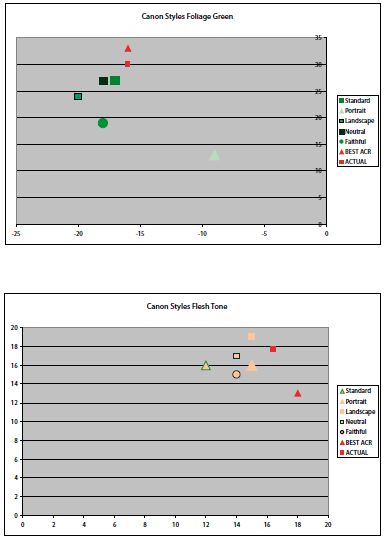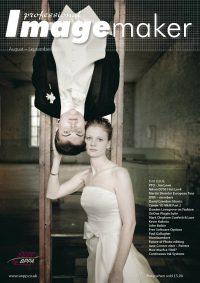articles/Cameras/canon1dmk3-page2
CANON 1D Mk III - part 2 of 1 2 3
by Mike McNamee Published 01/08/2008

Foliage Green
Only the Portrait setting exerted any real difference to the foliage values, reducing saturation by about 10 Lab points (note the colour is placed nearer the zero point at the bottom right-hand corner). The Landscape setting slightly enhanced the saturation but by only a small amount. All the values for the JPEG file were rotated towards cyan. The error of the Foliage Green was 3.18ΔE2000 in the ACR-corrected file, 6.95ΔE2000 in the Landscape-JPEG (with the vast bulk of the error being in the colour channels rather than luminance).
Skin TonesThese varied very little, indeed the errors between charts were of similar size to the variations due to Picture Style. These are true variations in that the measurement error between successive shots was about 20 times smaller. The Portrait setting sat right in the middle of the cluster, with little change being made. This tells us that the difference using corrected RAW is greater than any JPEG using a Picture Style. In summary then, the use of JPEG adds a little saturation to the image compared with a fully corrected RAW file optimised for colourimetric perfection. It is worth emphasising that colourimetric perfection is NOT the same thing as a preferred rendering of a scene - the first you might use for art-reproduction, the second at a wedding!
Overall Thoughts on Picture Styles
If you decide to shoot JPEG then Picture Styles are well worth experimenting with. However, you should realise that basic errors in your exposure of judgement or colour temperature are likely to overwhelm any changes that a style setting might make, or, in the worst case, exaggerate them. As ever RAW gives more flexibility at the expense of workflow time.

Action Shooting
As explained in the introduction, the Canon was tested in more trying conditions for the type of work it was designed to carry out - sport and action. Some of the sequences that were shot included subject movement, panning and zooming of the Canon 24-105mm f4.0 IS lens. Generally it performed well, the main sequence below was 18-frames, shot over 5 seconds, using 400 ISO and an aperture of f7.0. This called for exposures between 1/400 and 1/160 as the lens was zoomed between 105mm and 47mm, using aperture priority. This is a 1 1/3 stop span in 5 seconds. The exposures cannot all be 'correct' but neither is there time to adjust such a sequence. Manual exposure metering and fixed exposure would have made all the shots the same density.
The same part of the rider's green shirt ranges from 21 to 46% Luminance value. This serves well to reinforce the earlier comment that autoexposure cannot be relied upon to make the correct judgement and we didn't even have a bride's dress to fool the camera! Incidentally, only one of the shots is not focused correctly, which is not bad for an all-action sequence such as this.
Please Note:
There is more than one page for this Article.
You are currently on page 2 Contact Mike McNamee
1st Published 01/08/2008
last update 09/12/2022 14:52:07
More Cameras Articles
There are 0 days to get ready for The Society of Photographers Convention and Trade Show at The Novotel London West, Hammersmith ...
which starts on Wednesday 15th January 2025





